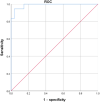Pepsin concentration in oral lavage fluid of rabbit reflux model constructed by dilating the lower esophageal sphincter
- PMID: 37745979
- PMCID: PMC10514679
- DOI: 10.1515/med-2023-0787
Pepsin concentration in oral lavage fluid of rabbit reflux model constructed by dilating the lower esophageal sphincter
Abstract
The aim of this study was to explore the changes in pH and pepsin concentrations in oral lavage fluid of rabbit reflux model. A total of 18 New Zealand rabbits were randomly divided into two groups. The lower esophageal sphincters (LESs) of the rabbits in the experimental group (EG) were dilated by balloon after the LESs were localized by manometry. The pH levels of the throat and the lower esophagus were monitored 1 week before and 2 weeks after inflation. Oral lavage fluid was collected 1 week before, and 2 and 8 weeks after inflation. The pH monitoring showed that the percentage of reflux time, the number of reflux events, and the longest time of reflux after the dilation (AE) in the EG were significantly higher than before the dilation (P < 0.01). The pepsin concentrations at 2 and 8 weeks AE in the EG were significantly higher than that before and that in the control group (P < 0.05). Based on receiver operating characteristic curve analysis, the best diagnostic threshold value was 30.3 ng/ml. The reflux model constructed by balloon inflation of the LES in rabbits is characterized by a decrease in throat pH and an increase in salivary pepsin concentration.
Keywords: animal model; balloon dilation; gastroesophageal reflux; laryngopharyngeal reflux.
© 2023 the author(s), published by De Gruyter.
Conflict of interest statement
Conflict of interest: All authors declare that they have no conflict of interest.
Figures



Similar articles
-
[Establishment and research of a New Zealand rabbit model of laryngopharyngeal reflux].Zhonghua Er Bi Yan Hou Tou Jing Wai Ke Za Zhi. 2019 Dec 7;54(12):912-918. doi: 10.3760/cma.j.issn.1673-0860.2019.12.006. Zhonghua Er Bi Yan Hou Tou Jing Wai Ke Za Zhi. 2019. PMID: 31887817 Chinese.
-
Correlation of salivary and nasal lavage pepsin with MII-pH testing.Laryngoscope. 2020 Apr;130(4):961-966. doi: 10.1002/lary.28182. Epub 2019 Jul 22. Laryngoscope. 2020. PMID: 31329290
-
Clinical relevance of salivary pepsin detection in diagnosing gastroesophageal reflux disease subtypes.Gastroenterol Rep (Oxf). 2023 Sep 13;11:goad053. doi: 10.1093/gastro/goad053. eCollection 2023. Gastroenterol Rep (Oxf). 2023. PMID: 37720194 Free PMC article.
-
Laryngoscopy findings and histological results in a rabbit gastroesophageal reflux model.Eur Arch Otorhinolaryngol. 2012 Aug;269(8):1939-44. doi: 10.1007/s00405-012-1968-9. Epub 2012 Mar 2. Eur Arch Otorhinolaryngol. 2012. PMID: 22382398
-
Assessment of clinical severity and investigation of uncomplicated gastroesophageal reflux disease and noncardiac angina-like chest pain.Can J Gastroenterol. 1997 Sep;11 Suppl B:37B-40B. Can J Gastroenterol. 1997. PMID: 9347176 Review.
References
-
- Koufman JA, Aviv JE, Casiano RR, Shaw GY. Laryngopharyngeal reflux: position statement of the committee on speech, voice, and swallowing disorders of the American Academy of Otolaryngology-Head and Neck Surgery. Otolaryngol Head Neck Surg. Jul 2002;127(1):32–5. 10.1067/mhn.2002.125760. - DOI - PubMed
-
- Cao J, Zhang LH, Wang WL, Wang YG, Li CF, Zhao YX, et al. Establishment and research of a New Zealand rabbit model of laryngopharyngeal reflux. Zhonghua er bi yan hou tou jing wai ke za zhi = Chin J Otorhinolaryngology Head Neck Surg. Dec 2019;54(12):912–8. 10.3760/cma.j.issn.1673-0860.2019.12.006. - DOI - PubMed
LinkOut - more resources
Full Text Sources
